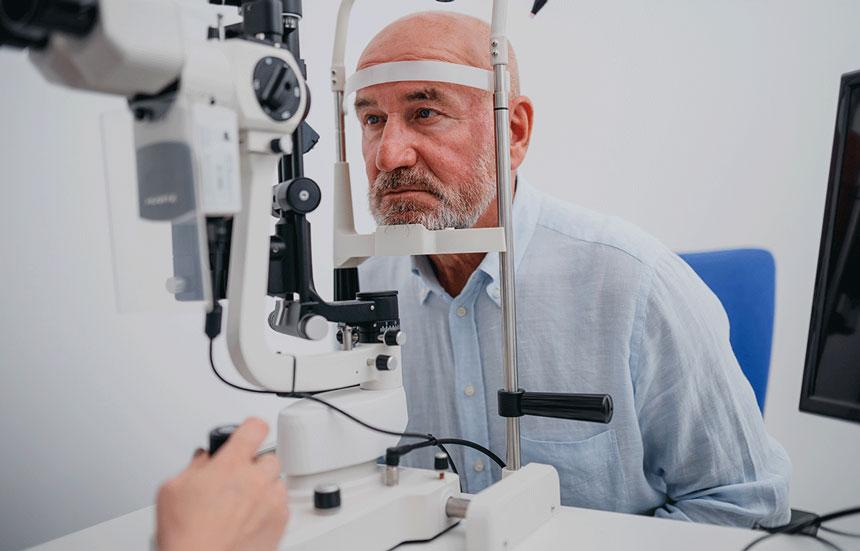Understanding Glaucoma

Currently, glaucoma affects around 3 million people in the U.S., but the number is expected to rise as the population ages. In fact, experts warn of a potential blindness epidemic if we don’t raise awareness of this disease. Glaucoma has no cure; however, early detection and careful monitoring can prevent significant vision loss.
Understanding Glaucoma
Glaucoma isn’t just one condition — it is several. The most common and the one most people associate with the word glaucoma is open-angle glaucoma. Open-angle glaucoma develops gradually and remains symptomless until significant optic nerve damage has occurred.
(The less common type — angle-closure glaucoma — can appear suddenly, producing severe symptoms such as eye pain, headaches, nausea and blurred vision. It requires immediate medical attention to prevent blindness.)
Risk factors for open-angle glaucoma include age, family history and ethnicity. African Americans over age 40 have a higher risk as do Hispanics and Latinos over age 60. Nearsightedness is also a risk factor.
What causes glaucoma?
Another risk factor linked directly to the development of the disease is increased intraocular pressure (IOP). This pressure is caused when the eye’s drainage system is inefficient or damaged, which can be caused by a number of factors.
If left untreated, this pressure, also called ocular hypertension, can damage the optic nerve and lead to glaucoma. Glaucoma can begin as early as your 40s and 50s, but since the first sign is diminished peripheral vision, it’s often overlooked. This is why it's frequently called the “silent thief of sight.”
But regular eye exams can help diagnose IOP and detect glaucoma. If you’re diagnosed with glaucoma, a typical treatment plan involves topical eye drops and or various laser and surgical procedures.
The Importance of Monitoring IOP
It’s important to track your IOP. Your doctor can monitor it through routine eye exams that involve measuring IOP, conducting visual field tests and assessing optic nerve structure and function. Keep in mind, IOP levels fluctuate, particularly if your optic nerve is damaged. And they’ll vary throughout the day. IOP is similar to blood pressure or blood sugar in that factors such as cortisol levels, medications, sleep patterns and positions and exercise can affect it.
Advances in Home Monitoring
Researchers at Johns Hopkins Johnson Laboratory have found that IOP spikes often occur between 4 a.m. and 6 a.m., times when patients are not typically seen in a clinical setting. These fluctuations might go unnoticed during regular office visits but can be crucial in managing the disease.
The good news is there’s now a way to check at home. The FDA-cleared iCare HOME2 device allows patients to measure their IOP, providing valuable data that can help doctors tailor treatments to prevent optic nerve damage. At the Moran Eye Center, where I work, we have numerous ongoing projects assessing IOP fluctuations with the iCare Home2 to better manage our patients’ glaucoma.
The iCare HOME2 device is easy to use and needs no anesthetic eye drops. The handheld device guides patients with lights to ensure proper alignment before taking measurements. The patient feels nothing. This home monitoring is especially beneficial for patients who have to travel long distances to get their IOP checked.
But the fact is that any patient with glaucoma on medications or having changes in therapies would benefit from knowing their IOP at various times of day. Similar to other chronic diseases, like diabetes and high blood pressure, better and tighter control leads to better outcomes. Frequent monitoring at different times of the day provides a more comprehensive view of IOP variations, which can lead to more effective treatment plans.
What You Can Do to Prevent Glaucoma
- Get routine eye exams. If you're 50 or older, get a comprehensive dilated eye exam either annually or biannually. If you have risk factors, start annual exams in your 40s.
- Talk to your doctors. Inform your medical and eye doctors about any risk factors and medications, especially steroids, which can increase your glaucoma risk.
- Adopt a vision-friendly lifestyle. Discuss your exercise routines and any history of high or low blood pressure with your eye care specialist. You also may want to protect your eyes from UV rays, avoid tobacco, eat a healthy diet and manage your weight.
- Consider home monitoring. If you have glaucoma, talk to your doctor about using the iCare HOME2 device (MyEyes.net) to monitor your IOP outside of usual clinical hours. This can help in adjusting your treatment plan to better control your IOP and prevent optic nerve damage.
By working closely with your eye care team and staying vigilant about monitoring, you can take proactive steps to protect your vision from the effects of glaucoma.
For more information, visit:
● The American Academy of Ophthalmology’s Page on What is Glaucoma
● Johns Hopkins Medicine’s Article on Home Monitoring of Eye Pressure
● MyEyes.net
Stay informed, stay proactive and protect your sight.


